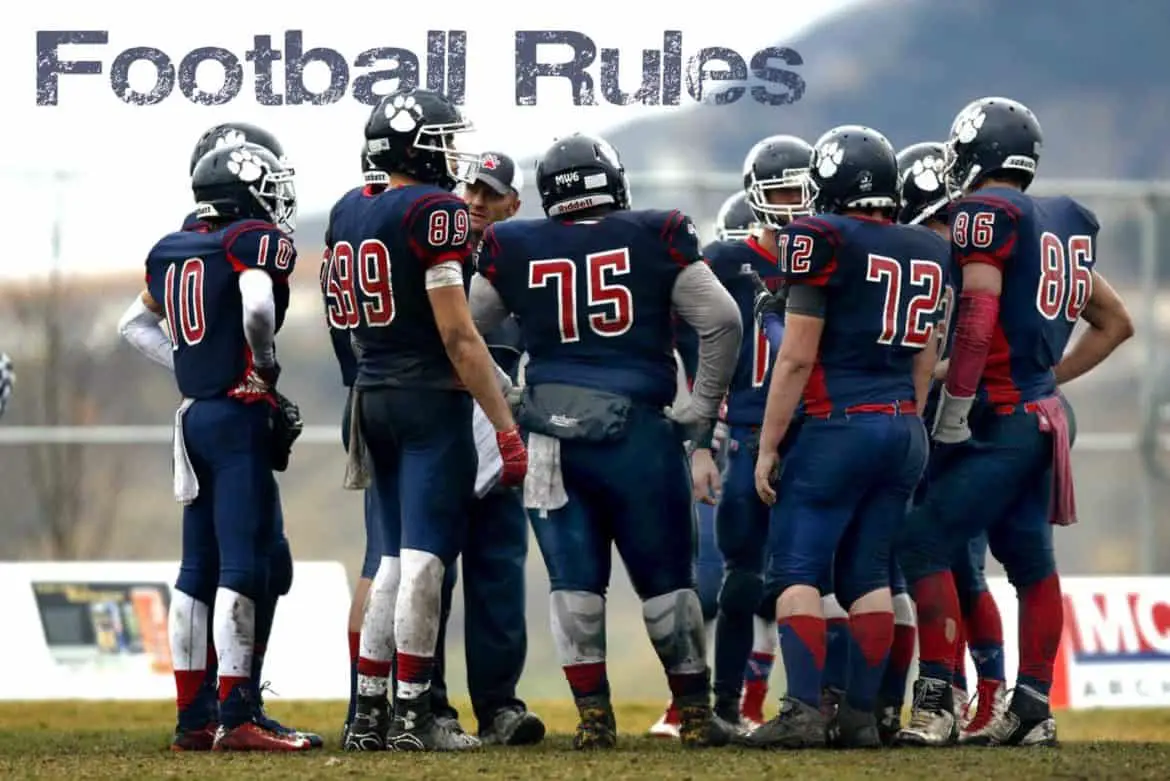Rules of American Football
NOTE: This article is a general overview of American football rules and will give you a very good idea of basic rules, scoring infractions, position basics, etc. However, this article DOES NOT cover every single aspect of each rule in excessive depth (like the exact dimensions of every part of each ball in each separate league, or the exact duties of each official on a field in each individual league, or an in-depth description of each and every foul or infraction that is possible).
Definition
It’s important to distinguish the term “football” and define it specifically. The term “football” is used worldwide to refer to the game commonly known in North America as soccer. With that in mind, I’ll use the term “football” to describe “American Football” which is the game played in the NFL (National Football League) in the United States and the CFL (Canadian Football League).
Overview
As a super-brief overview, football is a team sport where two teams compete. Each team sports eleven players on the field which is a large rectangular turf (real or artificial) playing area not unlike a soccer field. The objective for each team is to control (possess) the ball while advancing down the field to a goal line over which they must cross. Advances are made by either running with the ball or throwing the ball to another member of the team farther up the field (who may then continue to run if he/she can). If the recipient of a thrown ball (on the offensive team) catches the ball in the area across the goal line (known as the “end zone”), or if the player runs with the ball into the end zone, a score is attained. The other team (in defensive mode if they are not controlling the ball) tries to stop the advancing team from crossing into the end zone. The defensive team is also trying to regain control of the ball and start an offensive advance up the field in the opposite direction.
Each game (professional) has 7 referees on the field simultaneously.
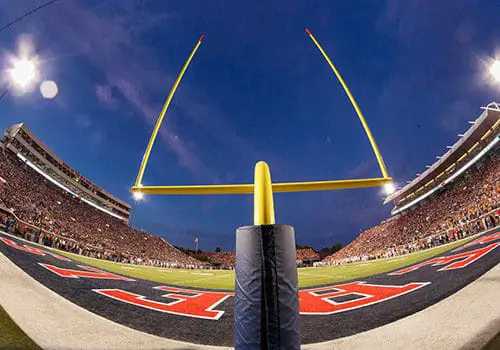
Rules of Play
Each end of the field contains a set of goal posts composed of two upright bars and a horizontal crossbar at their base. The two primary ways of scoring are for a team to either run into the end zone with possession of the ball (or catch a thrown ball while standing in the end zone) or by kicking the ball from a designated location on the field, through the goal posts.
To move the ball up the field, an offensive team is given four chances (known as “downs”) to move the ball 10 imperial yards. Each attempt to move the ball (by either throwing or running) is known as a play. When the play ends (usually a player is tackled by another player from the defensive team) it is known as a “down” (just think of the player “falling down”). If the offensive team does not move the ball 10 yards in 4 downs, the ball is turned over to the opposing team. If the team does make it 10 yards in 4 downs, they begin again with a new set of 4 downs.
A defensive team’s primary method of stopping the advance of the offensive team is to intercept a thrown ball or to tackle the player carrying the ball so as to quickly stop his advance.
The team with the most points at the end of the game wins!
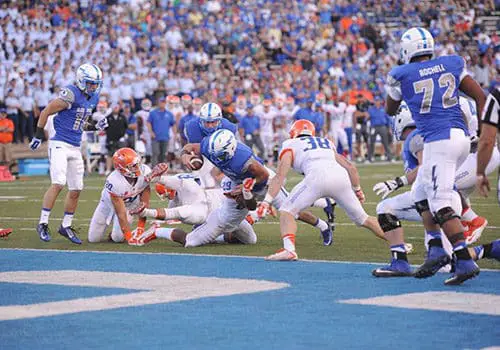
Scoring
Touchdown/conversions
The most notable way of scoring in football is with a touchdown. A touchdown is scored when the ball is advanced by running with it, or catching it in the end zone of the opposing team. A touchdown is worth six points after which another single point is attempted via a “conversion”. A conversion (also known as a PAT – point after touchdown) is attempted by the team who just scored a touchdown. The scoring team attempt to kick the ball from the 2-yard line (or 3-yard line – depending on the level of the league) through the goal posts.
Instead of kicking the ball for a 1-point opportunity, a team may elect to run or throw the ball (in the same manner as a touchdown is scored) into the end zone. If they are successful, they would receive 2 points rather than 1. A 2-point conversion is rarely attempted due to the much higher probability or chance of failure when compared to a 1-point conversion.
If the kicker fails to kick the ball between the goal posts on a 1-point conversion or a 2-point conversion attempt is unsuccessful, then no extra points are awarded other than the original 6 points for the touchdown.
Field Goal
A field goal is another common method of point-scoring whereby the team on offense nears the end zone into which they are attempting to enter. However, for a variety of strategic reasons, the offensive team may elect to not carry the ball all the way to the end zone but to kick the ball from the field through the goal posts. The kick must be attempted from a point no closer to the end zone than the advancing team is currently positioned and the ball must travel through the uprights and over the top of the crossbar (located 10 feet off the ground).
After a touchdown or a field goal, the team who has just scored continues the play by drop-kicking or place-kicking the ball from their own end of the field to the opposing team waiting on their end of the field.
Safety
A less common method of scoring is with a play known as a “safety”. A safety is scored when a ball carrier is tackled in his own end zone. This is usually accomplished by the opposing team which just kicked the ball to the ball carrier/recipient on the offensive team. A safety is worth two points (given to the defensive team which is the team who just kicked the ball).
A safety can also be scored during the game at any time if the ball carrier is tacked in his own end zone be it at the time of a kickoff or during regular plays down the field as a team slowly advances.
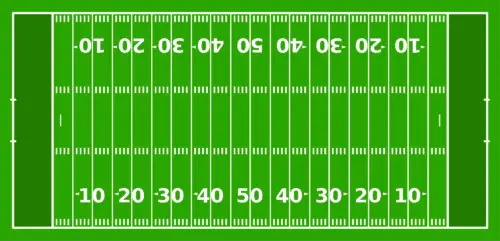
Play Zone / Field
The field on which a football game is played measures a total of 120 imperial yards in length and 53.3 yards wide. The goal lines are marked 10 yards from each end of the field leaving 100 yards of playing field in which the teams normally play. Easy to see markings (lines) are placed across the field at 10-yard increments and the numbers denoting each line are easily seen by players and spectators.
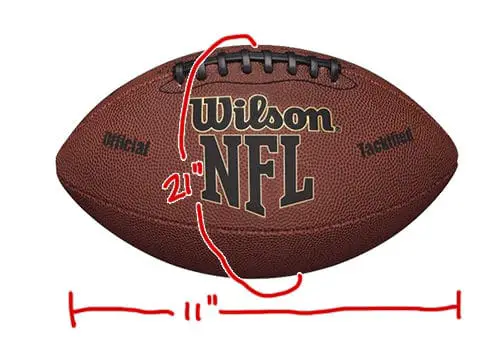
The Ball
The standard football used in professional and collegiate play is made from cowhide (must be as per the rules of both professional and college leagues). The weight is around 14 or 15 ounces. The shape of the ball is like that of an egg, but with more pointed ends (spheroid) and is inflated to around 13 lbs per square inch. The measureable exterior dimensions of the ball vary from league to league, but for NFL play, the ball is 11 inches long and the circumference around the center of the ball (short circumference) is 21 inches.
Ball sizes from other leagues like college (NCAA) are only slightly smaller (by fractions of an inch).
Goal Posts
The goal posts (through which a ball must be kicked) are situated at the very edge of the field boundary in the center of the field (side to side) and at the back of each end zone. The crossbar is 10 feet off the ground, while the two uprights (protruding upwards from each end of the horizontal crossbar) are 18 feet and 6 inches apart (NFL pro rules and collegiate rules). Posts are wider apart for high school play at 23’ 4”.
The height of each crossbar is 35 feet in the NFL and only a minimum of 10 feet in high school play. Padding is standard on each base of a goal post to prevent player injury.
Game Length (Duration)
In NFL/NCAA rules, a game lasts for 1 hour and is divided into 4 – 15 minute quarters. Each half (consisting of 30 minutes) is separated by an official half-time period with only a shorter pause between the first and second quarters and the third and fourth quarters.
Because of game stoppages (which actually make up most of the total game time), an average professional game lasts just over 3 hours.
Starting the Game
Typically, the two captains of each team meet with a referee at midfield for a coin toss. The visiting team is allowed to make the call of the coin toss (heads or tails) and the winner of the toss is allowed to decide between choosing whether to receive or kick off the ball or choosing which goal they want to defend, but they can also defer their choice until the second half. The losing team, unless the winning team decides to defer, is allowed to choose the option the winning team did not select, and receives the option to receive, kick, or select a goal to defend to begin the second half. Most teams choose to receive or defer because choosing to kick the ball to start the game would allow the other team to choose which goal to defend.
Infractions
Because the list of potential infractions is so vast, here is a taste of the type of infractions that are more common. Most infractions involve physical contact that is not allowed, and also a number of procedural offenses like moving at the line of play (scrimmage) or delaying the game, etc.
Pass-interference – making contact with an intended receiver of a pass before he catches the ball (presumably with the purpose of preventing the receiver from catching the ball)
Clipping – a defending player blocks a non-ball-carrying player from behind and below the waist.
Delay of Game – happens when a team deliberately tries to hinder the progress of the other team (offense) from moving down the field quickly (usually towards the end of a game). This action involves a delayed start of the play or down by the team committing the infraction.
Face Mask – involves grabbing the facemask of a player during a play in order to tackle or impede their progress.
Roughing the Passer – involves hitting or otherwise touching/pushing/etc. of a ball passer (usually the quarterback) after a pass has been thrown.
There are over 50 more infractions that involve physical contact that is not allowed as well as procedural actions during the game which are not allowed. Because the game is so physical to start with, many rules have been made to minimize injury. Many of the rules are easily avoided by using a level of common sense. Basically, don’t deliberately hurt an opponent in a sneaky or “unfair” manner, and you should be fine.
In most cases, a foul is punished by allowing the opposing team to gain an advantage by moving their advancing position further down the field, or by moving the team who committed the foul further away from their intended goal or target.
Positions
Each team plays on both offense and defense during the course of the match. This is a very rudimentary and simple explanation of the basic positions.
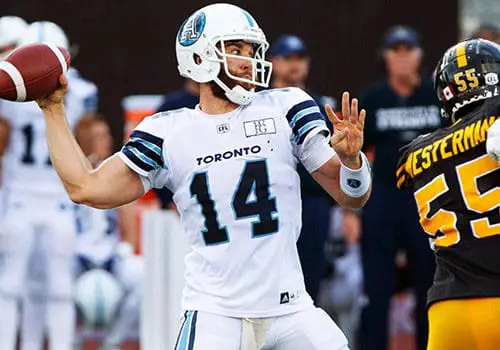
OFFENSE positions
(the team carrying the ball and trying to cross into the opposing team’s end zone)
The offense is classified into two main bodies. The 11 players are divided as follows: The first is the 5 offensive linemen. Their job is to block the defense and prevent them from tackling the quarterback or runner with the ball. The other 6 are backs and receivers whose job is to advance the ball down the field by either running with the ball or catching a pass thrown to them by the quarterback. Offensive linemen cannot advance the ball past the line of scrimmage (starting point of the play).
Center – A lineman in the middle of the offensive line of scrimmage who snaps or throws the ball between his legs and to the quarterback to start play.
Offensive Guard / Offensive Tackle – two lineman positions whose job is to block on any play whether it’s a running or a throwing play.
Quarterback – the player who receives the ball from the center to start play. The quarterback is the best-known position and often the most highly-paid position. The quarterback is the leader of various plays on the field and he will receive instructions from the coaches on the sidelines.
Running Back – the player who is in position to receive the ball from the quarterback and run a “rushing” or running play (as opposed to catching the ball thrown over a longer distance).
Wide Receiver – the player(s) who specialize in running fast, being agile and catching the ball which is often thrown erratically and under duress by the quarterback. Wide receivers try to elude the defense by speed and agility. They are often the players who receive long throw passes and run very quickly with the ball into the end zone.
Tight End – the player who is considered a cross between an offensive lineman and a wide receiver. Their roles are more diverse than the other positions.
DEFENSE Positions
The defensive team is the one attempting to prevent the offense from crossing into the end zone with the ball or kicking the ball through the goal posts to score. They accomplish their task by either forcing a turnover by intercepting a pass and taking possession of the ball, or by forcing the offense to turn over the ball by running out of downs.
Defensive Tackle – The player who starts in the middle of the line of scrimmage and tries to make his way through the offensive linemen to tackle the quarterback.
Defensive End – The players who start play on either side of the defensive tackle. They too are trying to tackle the quarterback or ball-passer and prevent any offensive plays towards the outside edges of the line of scrimmage.
Middle Linebacker – the player who leads the defensive line and calls the defensive plays
Outside Linebacker – the player who is often called upon to cover the other team’s running back during passing plays or rush to tackle the quarterback.
Cornerback – The players responsible for covering the wide receivers. They are usually quick and agile like a wide receiver and they often intercept the ball or swat it away. They are also called upon to tackle a runner with the ball or force him out of bounds.
Safety – The players used as a last line of defense to stop a ball carrier who runs with the ball from the line of scrimmage or catches the ball and gets past the cornerbacks.
Kicker – the player whose responsibility it is to kick the ball to start a play (kickoff) and for any extra point attempts like scoring from the field or a conversion after a touchdown.
Kick off Specialist – The player who is called on for doing kickoffs in the case where a kicker may not be as good. It’s a position that does not always exist on a team.
Punter – The player who kicks the ball in punting situations. He’ll receive a long snap and then drop the ball into the air and kick it before it hits the turf. This position is utilized in the scenario where an offensive team is on their 4th down and they relinquish the ball by punting it as far down the field as possible to make the other team (who now take the position of offensive) travel as far as possible.
Holder – the player who catches the ball from a long snapper (the guy who snaps the ball to the holder) and holds it for the kicker.
Returner – The player responsible for catching the ball from a kickoff or punt and running as fast as possible towards the direction from which the kick came. They are the fastest runners on a team.
Gunner – The player on the defensive team who runs as fast as possible down the field in an attempt to tackle the Returner.
Jammer – The player on the offensive team whose goal is to slow down a gunner in order to give the returner a maximum of protection to return the ball as far as possible down the field.
Some of these positions like Kick off specialist, returner, gunner and jammer are classified into a category called “special teams”.
Strategies
Football is a team sport that relies heavily on strategic plays involving psychology, trickery, etc. and it’s beyond the scope of this article.
History and Facts
Football originated in the United States from a mixture of two sports – soccer and rugby! Rutgers University and Princeton were the first two schools (teams) to play the sport in the first game on November 6, 1869.
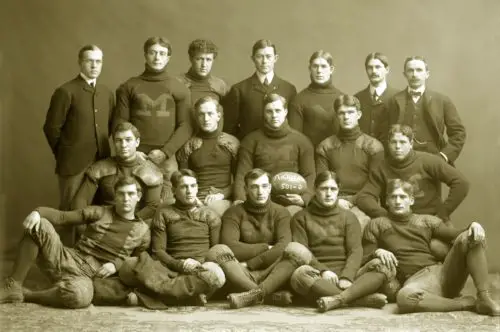
In its early years of evolving as a major sport, the rules changed often as bits and pieces of both soccer and rugby were adopted and then dropped. Football is the most popular sport in the United States. The National Football League (NFL) has the highest attendance of spectators of any professional sports league in the world. The annual revenue of the league is close to $10 billion.
The Canadian Football league is different in some of its rules, but overall it resembles the NFL very closely and it also evolved alongside the American version of Football.

